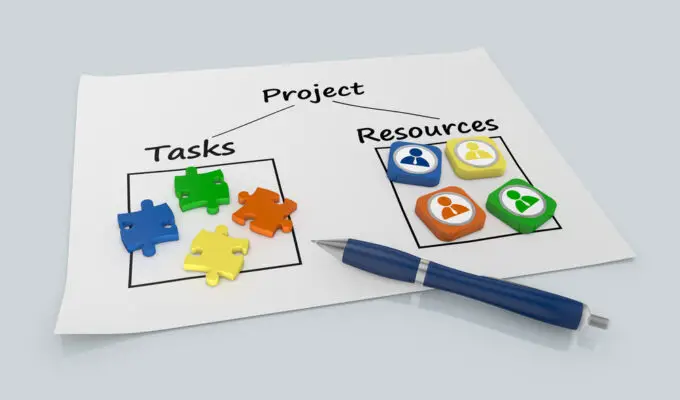Risk management is defined by ISO 31000:2018 as coordinated activities to direct and control an organization about risk. Risk management needs to include project risks as well as organizational risks. A project risk assessment identifies and prioritizes the impact and likelihood of various identified risks to a project and helps determine how to address them (i.e., respond, avoid, transfer, mitigate). Project risk management can be assessed using two approaches:-
1. Project duration, i.e., the timeliness of the project as shown from the project plan.
2. Project management stages, i.e., initiation, execution, or implementation.
The organization’s project management policy and enterprise risk management policy and framework will provide the basis for the chosen approach. The risk management process contains steps according to ISO 31000:2018 include:-
- Establishing the context
- Risk Assessment includes risk identification, risk analysis, and risk evaluation.
- Risk Treatment
- Monitoring and Review
Risk assessment is a process of identifying, assessing, and prioritizing risks as part of your overall risk management strategy. Risk assessments are used at the project level as well as the organizational level. An organization’s risk management policy and enterprise risk management policy and framework will significantly determine how you conduct a risk assessment. Regardless of which you start with, it is essential that you consider all relevant projects.
Risk management entails the analysis of risk and the adoption of a risk mitigation strategy. Mitigation plans are developed and implemented to reduce or prevent the consequences of risks – events that negatively influence the project.
Project Management
Project risk management is concerned about risks associated with project execution. All projects have essential requirements for the delivery of a successful outcome, and they must manage these uncertainties as best they can, including delay in results or lack thereof from those outcomes required by you – our client.

Steps to Perform a Project Risk Assessment
Risk is any factor that increases the probability of uncertainty or danger in an outcome or situation. It can be further defined as any factor or event that would affect delivering a project on time and within the provided budget.
The ability to correctly and accurately trace information about each project is key to its success as the project risk management mechanism. The aim is to review all project plans, evaluate each task and provide a means to identify risk. The risk assessment process for the risk management program for managing risk follows formal risk management tools for project risk.
Gather information on project plans – all of them. Ensure that you have access to current and retrospective project plans, including the main objectives, tasks, and activities already completed up to the present date. Also, ensure that there is a way of tracking any changes or refinements.
Identification of Project Risks
Process of finding, recognizing, and describing risks according to ISO 31000:2018. Project risks are identified through approaches like meetings, records, brainstorming. The attendees for such include the project implementation team (the team directly involved with the project), senior managers, other affected parties (if any).
Firstly identify what type of risk to working on – there are five common types: project management, technical risk, schedule risk, financial or economic risk, organizational, political risk, and people risks. For each category, identify the factors that are likely to cause delays in the project. It forces the team to think about how these factors could affect the project. Create a list of risks or potential risks using a risk register.
The lack of personnel with the necessary talents for the project or the unexpected absence of critical people are two examples of risks.With project stakeholders/staff members, brainstorm all of your present threats on the project. Assess the risks associated with the projects, such as those linked to project scope criteria, technology, materials/materials demands, and finances.
Risk Analysis Process
According to ISO 31000:2018, Risk analysis is a process to comprehend the nature of risk and determine the risk level. Organizations should understand the concepts and languages of risk and how they apply them in their project environment. Organizational context is the starting point for any risk analysis.
The risk analyses procedure is a component of a project’s overall risk management strategy. Throughout each stage of the project life cycle, project managers and the risk management team must manage the process.
A risk analysis approach is used to minimize the risks of your project. At best, an organization may have some risk management software to track and document your risk profile.
Risk analysis might be qualitative or quantitative in nature. To determine the risk rating of risk, likelihood and impact are multiplied to produce a rating. This rating can be either inherent ( without controls) or residual (after subjecting rules).
Determine the impact
Every risk has a potential effect, some of which are greater than others. Determine the existence of risk indicators and their impacts. Assign a high rating to these risks if they have a significant impact. Assign the rest of the risk a moderate risk level. What would happen if the risks previously identified were to occur. How will delivery affect projects budgets and timelines? Identify the project timeline, budget, and other factors that may influence your project plan.
Impact descriptions might be minor, moderate, major, or catastrophic, depending on the organization’s risk matrix.
Determine probability
The likelihood of risk is the most significant aspect to assess when it comes to evaluating project risk. In the range, list any potential outcomes, such as a rare, unlikely, probable, and almost certain indication of probability choices. It will ensure that you allocate your resources to reducing risks that could impact your project. If a specific supplier’s supply chain were to be disrupted, it would only be a risk factor if there was a persistent natural disaster in the supplier’s region.
Quantitative Risk Analysis
The project’s potential future effects are calculated, and the probability of attaining any goal is determined by applying quantitative risk analysis. Knowing how you will measure your progress and what conclusions you’ll reach may assist with planning, mainly when there’s uncertainty during the project planning stage. It’s essential to understand the technique. The Monte Carlo simulation is a type of quantitative risk analysis technique. This information is used to assist projects in making decisions. It reduces uncertainty and aids project control by providing the most significant degree of confidence.
It is determined by calculating the likelihood of it doing so. It tries to figure out what level of investment in resource allocation is required to achieve these goals and how probable it is.
The project’s potential future consequences are assessed, and the chance of meeting any objective is determined using quantitative risk analysis. When there’s uncertainty during project planning, knowing how you’ll measure your progress and what conclusions you’ll come to may help with planning.
Qualitative Risk Analysis
A project expert does a qualitative risk analysis. Experts examine the likelihood and probability of each risk for a scale or in a risk matrix based on their expertise and experience. The scale is usually set at 1 to 5, with one being the lowest and five being the highest. If your site’s chance to danger is 5, then the risk is considered to be almost sure that it will occur. If the risk is set to one, then it means that your risk is very unlikely to happen.
The qualitative approach examines the likelihood and impact of an event. For such evaluations, experience and training are typically factors. Depending on how it’s done, the expert’s view can be either a subjective or an objective assessment.
An expert’s subjective valuation is based on experience or religion, and it can be either correct or incorrect. Objective valuation of an event relies on statistical data such as the number of occurrences something has had in the past to estimate the chance of it happening again. Experts are still required to make subjective judgments on the importance of the potential impact of each risk. It allows for critical decision-making, which would otherwise be difficult or impossible with purely quantitative data.
It is essential to consider various possibilities when selecting options in scenarios that can produce adverse effects. Even the most unlikely of risks should be regarded as taking actions that can prevent them from occurring. After analyzing these outcomes, some may result in a serious problem while others are still possible but would likely have little consequence if they occurred.
When potential adverse effects are overlooked or disregarded because they appear improbable, one of the worst things that may happen is when possible bad results are ignored or dismissed. To avoid this, perform a qualitative risk analysis and evaluate all potential outcomes.

Risk Evaluation
ISO 31000:2018 defines risk evaluation as the process of comparing the findings of risk analysis. Not all risks are the same; some are more probable than others, and the expense of risk can vary greatly. It may assist in focusing mitigation efforts on the most critical threats.
Organizations may use risk criteria to help them conclude what precautions should be taken. It’s critical to remember the risk analysis findings and evaluate them against your goals, targets, and capacity for managing risks.
It is an integral part of a process that allows a risk manager to establish the measures and activities needed to manage risks. It helps them decide which ones need immediate attention and what type of action needs to be taken. Risk criteria can help determine whether a specific threat or opportunity will significantly impact the project.
Although the degree of vulnerability to risk is directly linked, there may be a positive relationship between project complexity and risk. The projects with innovative technologies are likely to have a higher level of sophistication and therefore increased risks. Complex technology necessitates more resources from the organization to accomplish project goals, and each of these resources might run into unique challenges. As a project manager, you must be able to identify and assess risk to manage risks throughout the life cycle of your project effectively.
Risk level
Stakeholders should be prepared for organizations to consider all risks, including delays in operations, project failure to meet deadlines, and a lack of strategy delivery. To calculate the risk appetite, you must first establish a company’s risk tolerance and then compare it to the organization’s risk requirements for risks of such types. The chance of a risk materializing and the impact it has once it happens may be measured. When the threat factor rises, so does the likelihood of various issues occurring. The degree of risks must be determined, and it may be helpful to use a scale ranging from ‘very high’ to ‘very low.’
The risk appetite is the degree to which a firm wants to take risks. It can help stakeholders understand how much risk they are willing to accept and limit how much risk they are prepared to tolerate. The amount of appetite will differ depending on the specifics of each project, but it should not alter throughout the duration of the project. Captured by the organization’s risk appetite policy and statement.
It is essential to understand that risk appetite, or level of tolerance for risks, should be related to the level of consequences when risks are materialized. For example, there are various levels of risk in using a particular technology for a business solution. It may have significant adverse effects on the business, which must be mitigated as they are costly and challenging to manage. In the meantime, an organization may choose not to invest in something new because it does not significantly benefit a business compared with its cost.
Risk Mitigation
The project team creates a risk mitigation plan to reduce the impact of unanticipated events. Risk avoidance creates a strategy with a higher probability of success but a higher cost than achieving the intended goal. A collaboration among others who are responsible for the risky activity is called risk sharing. Timeliness must be improved in activities with a history of delayed action to decrease the likelihood and impact of high-risk events.
Reducing risk is an investment in which we can reduce the project’s probability of failure. Risk reduction entails purchasing insurance on critical items that significantly impact our projects but are outside their control, such as excavation techniques and materials used for construction; it also includes developing alternative plans with teams (if something fails) to be used if necessary.
A team is more likely to respond quickly if they are prepared for the event. A risk-reduction plan can help them be aware and ready, so their decisions won’t face a time crunch as this one does.
Assign owners
The person with the most outstanding talent for managing and monitoring specific project risks should be in charge. Assign project risk owners using the project implementation team and stakeholders as a guide. Colla borate on the most acceptable feasible actions and when required to achieve optimal buy-in from your team members.
Assign a hierarchical level to each risk owner after identification. The most incredible owners will be responsible for additional implementation team members. Therefore they’ll be given the highest threat levels. They’ll then report on a progress basis at longer intervals than others. This method may assist the implementation team in planning.
Collaborating with other project managers is a great way to get your ideas across and ensure the team members know what’s going on. It can be helpful if you want feedback from everyone involved, but it also helps not to have any distractions like meetings happening while in-person discussions happen too!
A weekly meeting might do wonders for fostering good communication within projects as well – especially when held offsite or at more casual spots such as restaurants around town instead of conference rooms where people feel confined during their conversations about deadlines missed.
Regularly Review Project Risks
Managing risks is an ongoing process that begins with risk management at the beginning of any project and continues throughout its life cycle. Managers should set aside some time each week for discovery; monitoring logged items. Risk Management (or more specifically DevSecOps)Discovery – To manage these new threats, you’ll need tools like Splunk or Jira service desk tickets are never enough because they only tell us about one type of the problem which could be related but not necessarily cause it so being able to use correlative analytics can help alleviate this issue.
Risk Management isn’t just something we do once on our projects: It’s necessary to manage risks during every phase of development, even before starting work on a project. A review of a project risk register will identify risks for a risk event, thus providing a risk reduction method.
It is essential to find the best balance of different skills when it comes time for risk management. Humans often have difficulty understanding and foreseeing every possible scenario. At the same time, business users may not always be aware that some risks could affect them personally or financially, even though they might comprehend an idea on paper better than most people in this field would expect.
Monitor and Review the Project Risks
Risk management is a necessary process that should be reviewed and monitored throughout the duration of your project. Building procedures can mitigate risk into a plan to reduce them where essential, so organizations don’t have any unease at reaching goals on time or under budget with fewer potential risks associated in return for completing objectives and ensures successful risk management.
A particular risk of complex projects that affects the project budget will be managed through the risk mitigation approach of project schedule by using a risk assessment plan and providing significant price incentives in a project risk plan. High impact risks which the project team identify, in a risk assessment meeting to evaluate risk.
The risk management plan is an essential part of any project. This way, we can protect against the risks and reduce their severity if not eliminate them. The risk management process should be maintained throughout the entire project. Risk can be mitigated, but you need to develop procedures to reduce such risks as much as possible so that if we reach our goals on time and under budget with fewer potential risks associated.
Conclusion
If an organization wants to execute a successful project, it is essential that you plan for the unexpected by performing a risk assessment. The project team mitigates risks and assist in project risk mitigation programs. After all, there are many ways that your project can be derailed before or during execution. In this blog post, we’ve outlined eight steps for conducting a project risk assessment. Follow each one of these steps and take time at various points throughout the process to evaluate how well-prepared your team members are as they work towards completing the task on schedule without any issues arising along the way. Do not forget to assign owners who will monitor and review risks regularly. If anything does come up, they have already been alerted in advance and prepared with solutions.
Chris Ekai is a Risk Management expert with over 10 years of experience in the field. He has a Master’s degree in Risk Management from University of Portsmouth and is a CPA and Finance professional. He currently works as a Content Manager at Risk Publishing, writing about Enterprise Risk Management, Business Continuity Management and Project Management.

